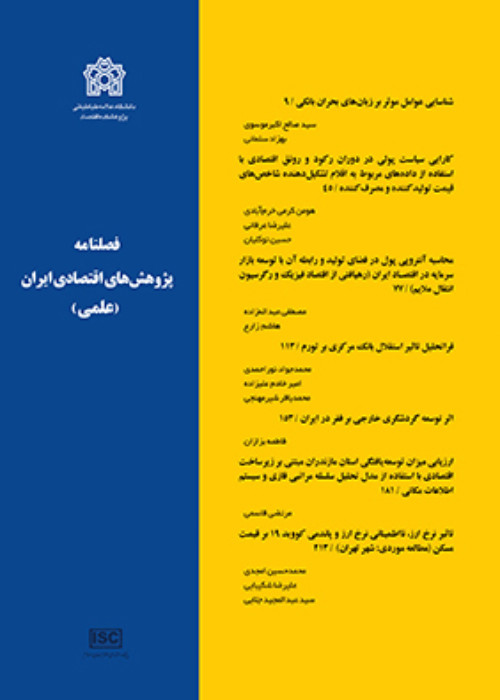Investigation of the An Empirical Analysis of Stock Market's Fluctuations and Information Efficiency; A Case Study for Tehran Stock MarketDemand for Subsidized Food in Urban Areas of Iran, Using AIDS Model for Priority Subsidy Allocation
Author(s):
Abstract:
Stock markets are strong means of attracting savings and directing them to investors, but their rate of returns are subject to fluctuations much higher than other economic variables. This paper is to examine of the volatility in the Tehran stock marketusing the conditional heteroscedasticity technique for the period 1370:0-1386:06. Based on the results obtained, (1) distribution of the return has positive skewness indicating that market players consider occurrence of negative returns more likely. (2) Return series is not normaly distributed and has more height than normal curve. (3) Calendar has no significant effect on return with the exception of second, fifth and ninth months of the year. (4) Weak Information efficiency is rejected. Thus, not all market factors transact professionally and, the information and the news affect stock price with a time delay. (5) Inflation has positive effect on returns fluctuations, but is not significant. (6) Exchange rate (Rials/$) has positive and significant but samll effect on return fluctuations. The small effect is probably due to the fact that there is only a little share of Dollar in shareholders portfolio. Finally, (7) Assumption of normal distribution for residuals is not suitable. In contrast, t and general error distributions if surplus kurtosis is considered are proper assumptionsGovernments can play have an important role in affecting the demand for planning and preparing the food these security through their protection policies such as providing subsidies. subsidizing the main or basic categories of food in the same time subsidies will increase the government expenditure,therefore, it is necessary to set goals carefully. However, as subsidies will increase government expenditure and will cost the economy, they should be targeted to people who need them the most. In this article, we estimate the demand for main or basic foods, (i.e.bread, meat, milk, oil and sugar) have been estimated by using AIDS Model and taking into account household budget survey data in urban areas and consumer price index through two stage model and cointegration for the periodyears 1363-1384. At every stage, estimation was done for both the short-run and the long-run and the homogenous constraint and symmetric have been examined by Wald test. As an instrument of analysis, We obtain price elasticity, income elasticity and cross price elasticity of demand have been calculated forin the short-run and the long-run. The results show that reducing subsidies on these goods would put a pressure on consumer expenditure through the rise in the prices. However, changes in the structurel of subsidies with a gradual reduction in the amount of subsidies for bread, oil and sugar and directing them payment toward meat and milk within a structured goal is recommended.will be more beneficial.
Language:
Persian
Published:
Iranian Journal of Economic Research, Volume:13 Issue: 40, 2009
Page:
29
magiran.com/p709320
دانلود و مطالعه متن این مقاله با یکی از روشهای زیر امکان پذیر است:
اشتراک شخصی
با عضویت و پرداخت آنلاین حق اشتراک یکساله به مبلغ 1,390,000ريال میتوانید 70 عنوان مطلب دانلود کنید!
اشتراک سازمانی
به کتابخانه دانشگاه یا محل کار خود پیشنهاد کنید تا اشتراک سازمانی این پایگاه را برای دسترسی نامحدود همه کاربران به متن مطالب تهیه نمایند!
توجه!
- حق عضویت دریافتی صرف حمایت از نشریات عضو و نگهداری، تکمیل و توسعه مگیران میشود.
- پرداخت حق اشتراک و دانلود مقالات اجازه بازنشر آن در سایر رسانههای چاپی و دیجیتال را به کاربر نمیدهد.
In order to view content subscription is required
Personal subscription
Subscribe magiran.com for 70 € euros via PayPal and download 70 articles during a year.
Organization subscription
Please contact us to subscribe your university or library for unlimited access!



